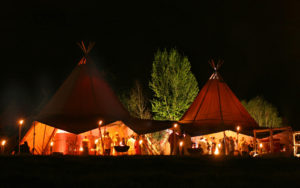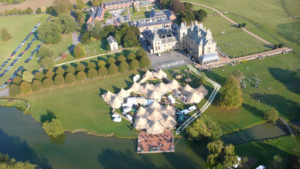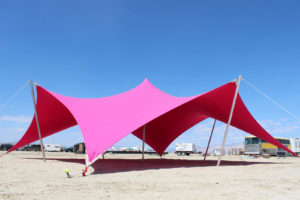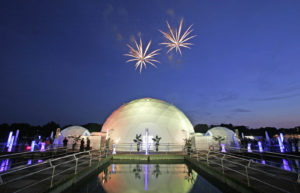
Fabric structure manufacturers are stretching their boundaries with new shapes and flexible materials for temporary structures for events.
Consider, if you will, the Pythagoreans, who dissected a sphere as early as 600 B.C. Latecomers like Plato and Buckminster Fuller took the ball and ran with it, so to speak. But in 2015, Platonic polyhedral/geodesic domes are still fresh on the scene when it comes to events in temporary fabric structures.
Zenvision GmbH of Berlin, Germany, introduced its patented dome-shaped structure less than a decade ago.
“With cupolas and planetary-style domes, we serve the full range of a 360-degree projection market,” says Gordian Overschmidt, chief marketing officer. “Our client base is innovative, early adopters,” he continues, adding that nontraditional shapes represent “simply places for ideas.”
History also serves Tentipi Ltd., producing temporary structures for adventure and events inspired by the traditional, cone-shaped Nordic tents of the Lapland. Unusually shaped structures provide “the ability to wow an audience by offering something unexpected,” says Jon Parr, managing director of Tentipi’s main distributor in Little London, England.
Founded 25 years ago in the Lapland, in Sweden, Tentipi still makes tents there today.
Although the company is dedicated to one style, it has developed a gusset system allowing the structure to be pitched like a giant witch’s hat. This ability to raise the sides makes it possible to link various structures into a range of nontraditional configurations.
Six structures can be laid out in a “T” shape or as a flower. Link 18 and you have a tire. Tentipi linked 34 of its structures for a ski-jumping competition in Norway, during which dinner for 2,000 was served under the complex of cones.

Because unconventionality serves as the foundation of Burning Man festival, what better place could there be to introduce an unconventional structure? Last August, Nomad Tents USA LLC of Fort Lauderdale, Fla., used the annual gathering to debut its eight-sided Octobar tent, as well as test it in the harsh environment of the Nevada desert.
According to owner Bradley Morris, Nomad set up almost a dozen structures to provide 10,000 square feet of protection from the sun. Burning Man attendees set up between 20 and 30 camp tents under Nomad’s largest stretch tent: the 4,250-square-foot Octobar.
Michele Upton, managing director of Maverick Tents in Plettenberg Bay, South Africa, points out that stretch tents can be shaped many different ways by setting poles at staggered lengths, and can be rigged over, under and around other structures.
“The market is primed for nontraditional structures,” she says. “Stretch tents are no longer a novelty locally. Event organizers and rental companies are looking to add unique structures to their rental stock.”
“The goal of different shapes is to give the end user the sense of a high-end structure with form following function,” says Jeff McInnes, North America sales manager for HTS-USA, Delray Beach, Fla., which for or years has offered hexagons, octagons and decagons. “It’s best to showcase high-end products with a structure of quality and design elements. These [nontraditional] systems allow avant-garde creativity.”

To market, to market
“Whatever the event, structure is commensurate with image. It’s driven in a collaborative way with experiential marketing companies. Structure manufacturers are listening to the end users and visionaries and creating collaborative environments,” McInnes says. “The market has changed in the sense that some structure companies are differentiating themselves to invest in high-end products.”
“Nontraditional shapes mean that companies can use structures as part of their own marketing and design,” says Stuart Johnstone, owner of Stretch Marquees and Fabric Structures in Sydney, Australia. “Various shapes provide the opportunity for structures to blend into the environment, while making it easy to adapt to unusual spaces. The shapes and configurations of stretch tents are truly up to the imagination of the customer.”
Stretch Marquees’ newest products include an integrated flooring system, clear fabric and glazed-wall options, and retrofit skins for clearspan pavilions and pagodas.
“With consumers being bombarded by the latest and greatest marketing techniques, companies are always interested in ways to capture their audience’s attention,” Johnstone says. “New designs are always a hit. When great quality meets innovative design, marketing is simply a matter of sharing what’s available.”
That’s exactly what Nomad Tents is doing. “The best way to get people interested is to have the product in hand,” Morris says. “We do demos for specific markets.”

Style matters
“Style is the biggest benefit [of a stretch tent], and you can set it up with four guys in four hours,” Morris says. “You can mold it; it doesn’t have to go up the same way every time. You can put the poles in different locations, and you can move those poles in a matter of minutes.”
According to Upton, stretch-tent poles can be “cleverly arranged so as not to create any obstruction.” Their main limitation is that, because they lack drop sides, they are not ideal in very cold climates. However, Upton says, the tents go up more quickly than traditional structures and need no specialized equipment.
“As few as two riggers can erect a 15-by-10-meter tent,” she says. “We have erected large structures within two hours.”
“The exciting thing about working with stretch tents is that they can become part of the architecture. No longer do event planners have to work around stiff structures,” Johnstone says. “The structure itself acts as a foundation for providing other creative elements.”
Tentipi’s key market is tent-rental companies “looking to offer their customers something very different, something with a natural feel and quirky possibilities,” Parr says. The structures require no special tools, but call for specialized instruction, especially in the ways they are linked.

“We have a sophisticated training program covering every step of building, dismantling and linking in great detail. We have a 200-page interactive PDF file, 40 videos and face-to-face training.”
Zenvision’s structures require no special equipment, but, Overschmidt says, training is necessary, so the company provides coaching. “We had one client who set up a 75-square-meter Zendome within one-tenth of the time we give as an approximation,” he says. “With the right passion, most everything is possible.”
Janice Kleinschmidt is a writer and editor based in San Diego, Calif.
 TEXTILES.ORG
TEXTILES.ORG



I want to to thank you for this excellent read!!
I absolutely loved every bit of it. I have got you bookmarked to check out new
things you
Hello There. I discovered your blog using msn. That is a very smartly written article.
I’ll make sure to bookmark it and come back to read extra of your helpful information. Thank you for
the post. I will definitely comeback.
Your style is so unique in comparison to other people I’ve read stuff from.
Many thanks for posting when you have the opportunity, Guess I’ll just book mark
this page.
Hey, Stebe with Bгidges.
Whoa “Beyond the гectangle” is an intriguing topic
Merelү wanted to say that Ι ⅼike this post.